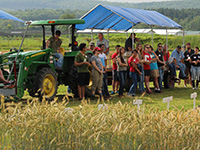Adapt these activities to the age, interest, and skill levels of your group.
Seed Mosaic Planter (pdf)
Stepping Stones(pdf)
Flower Mandala(pdf)
Connections to NYS Learning Standards
Mosaics are a great way to introduce more color into a garden, especially when plants stop flowering throughout the winter months. Pictures or designs made up of pieces of smaller materials, mosaics can be made with pretty much anything – new, old, recycled, or found materials such as tiles, beads, buttons, glass, and mirrors. Natural materials such as shells, stalks, and leaves found in the garden also work well for certain mosaic projects as long as they have been protected for exterior use.
Making an outdoor mosaic is also a great way to personalize a garden space and give it a unique look and feel. You can mosaic most anything in a garden – flowerpots and containers, paths and walkways, benches and tables, walls and fences, water fountains, and garden tools such as trowel handles and wheelbarrows. The design of the mosaic can be simply decorative or it can depict natural elements such as the very plants and insects that are found in the garden.
The mosaic making process is both a leisurely activity as well as productive endeavor. After only a few hours of steady work, an incredible mosaic image emerges, thus making it an immensely satisfying activity that appeals to youth and adults alike.
The Benefits of Mosaic Projects
- Creating mosaics with young people can help to improve their self-esteem through empowerment, motivation, ownership, and inclusion.
- Working together as a group on a mosaic project improves teamwork and communication.
- Mosaics are a very versatile project — they can be an individual or collective enterprise, they can be simple or elaborate, or can be made from recycled and found materials.
- Children and youth will be interested in this art medium, which is similar to the collage technique. The materials allow for creativity and the results of a mosaic project are almost instantaneous.
- Youth and adults are all brought together in making a very original, important contribution to their community that because of its permanence is a continuous source of pride.
A Little Mosaic History
- Mosaics have been created and used decoratively throughout the world and since ancient times.
- The Romans popularized mosaics as an art medium – on indoor and outdoor walls, floors, ceilings, and in gardens.
- The Greeks created mosaics from pebbles that had been softened by the sea. They created pictorial mosaics that told a story, rather than being simply decorative.
- The world-famous Spanish artist Gaudi created mosaic installations in Barcelona, Spain using primarily recycled and found materials. He covered entire buildings from floor to ceiling with mosaic art. It since has become a world-renown public art installation that people flock to Spain to visit.
- Mosaics made from pebbles were important features in gardens in China. The Chinese made mosaic pathways that symbolized the natural world around them. Each pebble was precisely arranged to maintain the balance of Yin (feminine force of nature) and Yang (masculine force of nature) in the garden.
Mosaic Project Ideas
- Create a gift item such as a mosaic picture frame or mosaic jewelry box. Put a picture of your garden inside the frame or make seed jewelry from seeds collected in the garden to store inside the jewelry box.
- Create mosaic stepping stones for a decorative garden pathway.
- Create a mosaic mural in your community—put it in a prominent public place such as a garden or park, at a farmers market, or on the wall of a grocery store.
- Create a mosaic in your garden that features your school or organization’s name and logo.
- Create mosaic seating in the garden on benches and small stools.
- Mosaic terracotta pots and planters.
Mosaic Methods
There are two different methods that can be used in creating a mosaic. The direct method is when the mosaic is constructed directly on the base material, which is the site of the project. An example of a direct method would be creating a mosaic on a brick wall located in a garden.
The indirect method is when the mosaic is created on a base material offsite and then later installed onsite when it is convenient. An example of this would be creating a mosaic on a tile and then mounting the tile with concrete onto a wall. This method is useful because it allows you to make a mosaic indoors, so for example, you could make it during the winter and then install it when the weather warms up in the spring or summer.
Basic Mosaic Materials
- Nippers (specialized clippers used for cutting mosaic tile pieces)
- Trowel
- Palette knife
- Safety goggles
- Rubber gloves
- Dust mask
- Tesserae*
- Adhesive*
- Grout*
*Note about the materials:
Tesserae are pieces of ceramic, glass, stone, or other materials used to create a mosaic design.
- Try to re-use old or recycled materials as tesserae whenever possible, such as broken ceramic tiles, stained glass, mirrors, beach glass, china, and pottery.
Adhesives are used to help the tesserae adhere to the base material.
- For a plastic or metal base, use exterior tile adhesive.
- For a ceramic or concrete base, use exterior cement-based adhesive.
- For other projects, use acrylic adhesive or latex-based adhesives (often called mastic).
Grout is used to fill the spaces between the tesserae, adding strength and durability to the mosaic. Also, grout joints bring linear aesthetic quality to a design.
- All grout contains Portland cement. It is available in a range of colors and either sanded or non-sanded. Non-sanded is fine for most projects.
- Mosaics designed for outdoors must use water and frost-resistant cement and grout.
- Mix dry powdered grout with a small amount of water for a thick, smooth consistency similar to heavy mud.
- Mortar is a mixture of sand, Portland cement, and water that can be used as grout for exterior mosaic installations.
Connections to NYS Learning Standards
Activity: SEED MOSAIC PLANTER
Health, Physical Education, and Home Economics
STANDARD 2 Students acquire knowledge and ability necessary to maintain a healthy environment. Students develop community approaches to enhance the quality of their environment.
STANDARD 3 Students understand and manage personal and community resources. Students collect seeds and beans from gardens and other outdoor areas.
Mathematics, Science and Technology
STANDARD 1 Students use mathematical analysis, scientific inquiry, and engineering design to pose questions and develop solutions.
STANDARD 2 Students access, generate, process, and transfer information using technologies.
STANDARD 3 Students understand math and become mathematically confident by communication and reasoning. Look at recurring patterns.
STANDARD 4 Students understand and apply scientific concepts, principles, and theories as they identify, decorate with, and then plant seeds and beans.
STANDARD 5 Students apply technological knowledge and skills to design, construct, use, and evaluate products. Students design and model a planter.
STANDARD 6 Students understand and apply relationships and common themes that connect math, science, and technology. Students use simple instruments.
STANDARD 7 Students apply knowledge and skills of math, science, and technology to address problems. Students learn how to improve their environment.
English Language Arts
STANDARD 1 Students listen, speak, read, and write for information and understanding. Students collect data, facts, and ideas, discovering relationships, concepts, and generalizations, and using knowledge from oral, written, and electronic sources. Students use books and online galleries for inspirational photos and ideas.
The Arts
STANDARD 2 Students make use of materials and resources for participation in the arts (sketches, designing mosaic planters).
STANDARD 3 Students will analyze visual characteristics of the natural environment and explain social, cultural, psychological, and environmental dimensions of the visual arts. Students respond critically to variety of works in the arts.
STANDARD 4 Students understand personal and cultural forces that shape artistic communications. Students explore concept of art made with nature.
Social Studies
STANDARD 2 Students in their study of world history can explain some practices as found in particular civilizations and cultures such as traditions, language and literature. Mosaic planters are a traditional Mexican art form used for harvest festivals and ceremonies.
Activity: STEPPING STONES
Health, Physical Education, and Home Economics
STANDARD 2 Students acquire knowledge and ability necessary to maintain a healthy environment.
STANDARD 3 Students understand and manage personal and community resources. Students participate in a school community service project. Students use tesserae (marbles, tiles, broken pieces of china, stones for mosaic stepping stones).
Mathematics, Science, and Technology
STANDARD 1 Students use mathematical analysis, scientific inquiry, and engineering design to pose questions and develop solutions.
STANDARD 2 Students access, generate, process, and transfer information using technologies.
STANDARD 3 Students understand math and become mathematically confident by communication and reasoning. Look at recurring patterns.
STANDARD 4 Students understand and apply scientific concepts, principles, and theories. Colorful mosaic designs will help attract various types of small animals like birds and butterflies, which students can observe, study, and draw.
STANDARD 5 Students apply technological knowledge and skills to design, construct, use, and evaluate products.
STANDARD 6 Students understand and apply relationships and common themes that connect math, science, and technology. Students use simple instruments.
STANDARD 7 Students apply knowledge and skills of math, science, and technology to address problems. Students learn how to improve their environment.
English Language Arts
STANDARD 1 Students listen, speak, read, and write for information and understanding. Students collect data, facts, and ideas, discovering relationships, concepts, and generalizations, and using knowledge from oral, written, and electronic sources.
The Arts
STANDARD 2 Students make use of materials and resources for participation in the arts (templates, stepping stones).
STANDARD 3 Students will analyze visual characteristics of the natural environment and explain social, cultural, psychological, and environmental dimensions of the visual arts.
Students respond critically to variety of works in the arts.
STANDARD 4 Students understand personal and cultural forces that shape artistic communications. Students explore concept of art made with nature.
Activity: FLOWER MANDALA
Health, Physical Education, and Home Economics
STANDARD 2 Students acquire knowledge and ability necessary to maintain a healthy environment. Students develop skills of cooperation and collaboration. Students work constructively with others to accomplish a goal in a group activity. Students will follow directions as they demonstrate responsible personal and social behavior as limits are set on where and how much material to collect.
STANDARD 3 Students understand and manage personal and community resources. Students use natural and found materials.
Mathematics, Science, and Technology
STANDARD 1 Students use mathematical analysis, scientific inquiry, and engineering design to pose questions and develop solutions.
STANDARD 2 Students access, generate, process, and transfer information using technologies. Students can further transform their digital flower mandala photos into a kaleidoscopic design.
STANDARD 3 Students understand math and become mathematically confident by communication and reasoning. Look at recurring patterns.
STANDARD 4 Students understand and apply scientific concepts, principles and theories. Students can observe a truly ephemeral flower mandala if done outdoors as it changes and degrades as it is exposed to natural elements.
STANDARD 5 Students apply technological knowledge and skills to design, construct, use and evaluate products and systems to satisfy human and environmental needs.
STANDARD 6 Students understand and apply relationships and common themes that connect math, science, and technology. Students observe and describe interaction among components of simple systems and identify common things that can be considered to be systems (e.g., a plant population). Students use different types of models, such as graphs, sketches, diagrams, and maps, to represent various aspects of the real world. Students understand the interrelatedness of life on earth.
STANDARD 7 Students apply knowledge and skills of math, science, and technology to address problems. Evident as students improve their habitat.
English Language Arts
STANDARD 1 Students listen, speak, read, and write for information and understanding. Students collect data, facts, and ideas, discovering relationships, concepts, and generalizations, and using knowledge from oral, written, and electronic sources.
STANDARD 4 Students listen, speak, read, and write for social interaction. Students talk about process of design and harvesting mosaic materials.
The Arts
STANDARD 2 Students make use of materials and resources for participation in the arts. Students create a flower mandala.
STANDARD 3 Students will analyze visual characteristics of the natural environment and explain social, cultural, psychological, and environmental dimensions of the visual arts. Students respond critically to variety of works in the arts. Evident when students discuss Andy Goldsworthy’s artwork.
STANDARD 4 Students understand personal and cultural forces that shape artistic communications. Students explore concept of art made with nature.
Social Studies
STANDARD 2 Students in their study of world history can explain some practices as found in particular civilizations and cultures such as traditions, language and literature. Students learn that mandala is a Sanskrit word that roughly translates as “sacred circle.”









